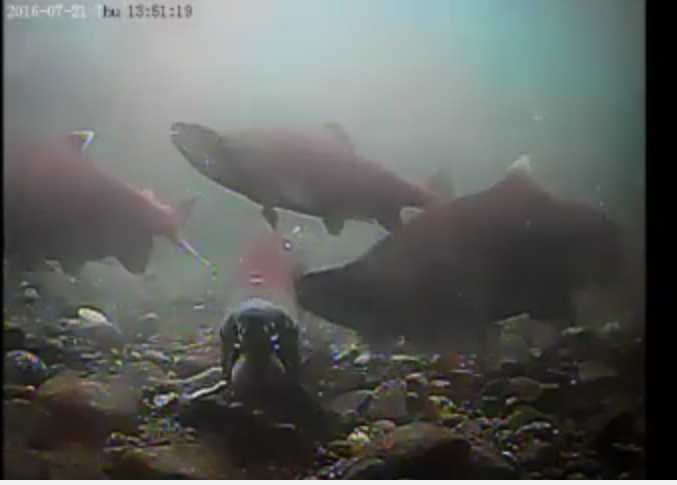At 4:30 p.m. on a Tuesday, a beaver slept in its den on Steep Creek near the Mendenhall Glacier, its furry face aimed at an infrared camera streaming on Youtube. Seven users tuned into the cam to watch the peaceful rodent recoup on its straw bed.
To Robert J. Lieberman, viewing the channel from Fox, Alaska, the cams are part inspiration, part therapy.
“I can’t resist… I tune in, or reload the web page every couple of hours. … Yesterday I’m pretty sure I saw one, the bigger one maybe, gnawing in his sleep … Do beavers dream of gnawing?” Lieberman wrote in an email to the Empire. “(I) like to think they’re napping peacefully in their comfy lodge after an honest nights work. They don’t need to know … the monstrous things people are doing to one another around the world.”
The beaver dam live feed has gotten 10,625 views this year with people viewing from as far away as Poland, Saudi Arabia and Kazakhstan. The average viewer watches the feed for nearly 10 minutes.
The U.S. Forest Service has run the camera from the Mendenhall Glacier Visitors Center since 1995 and began live-streaming in 2009, according to Natural Resource Specialist Peter Schneider, who runs the feed. Because of bandwidth limitations, the Forest Service can only stream one camera at a time; they switched their feed from the beaver den to an in-river sockeye feed Thursday.
The beaver cam features a sedate, peaceful scene, with one or two of the nocturnal animals sleeping during the day, occasionally shifting position. The sockeye cam has more action with hens digging redds to lay eggs and males jockeying for position on the creek.
“I noticed early on the fact that it’s a live view is what made it different. If you tell somebody we have some old highlight footage of sockeye and you can talk about the behavior, people are interested. If I have less exciting footage but it was live, people’s interest level quadruples,” Schneider said in an interview at the Mendenhall Glacier Visitors Center. “The fact that it’s live and right here, right now, people connect with it more. Their attitude is so much different.”
The Forest Service has made a recent commitment to reach out via digital strategies and social media.
“Digital strategy, for our agency, means using any form of digital application to reach out and connect with the public. With social media we’re still learning, like everyone, how to maximize that and give back,” Schneider said as he walked along the Moraine trail by Mendenhall lake. “We don’t have a product to sell, but it’s more about how do we give back? How do we educate people about what’s out there that they can enjoy, and that’s one way to do it. It’s really a great way to interact with people because these are their tax dollars.”
The cameras were originally installed by local eagle scout Matt Statsney as part of a service project. Statsney dug the line from Steep Creek and installed the donated hardware which he connected to a kiosk at the bottom of the Mendenhall Glacier Visitors Center.
The technology has come a long way since Statsney spearheaded the project. Originally the cameras plugged directly into TVs through long coaxial cables. Schneider has since upgraded to IP cameras, which allow him to send the feed directly up to a control station behind a disguised door in the visitors center.
Installing and removing the beaver den camera is a delicate job. The last thing Schneider wants to do is disturb a beaver den or salmon spawning grounds.
“It all has to be buttoned up. I have to have flexible conduit and no exposed wires because if the beavers chew that up, the camera’s done,” Schneider said. “Then I attach it to the bottom of a PVC pipe. During the initial time, I have to look for appropriate chambers in the den. Sometimes I stick the camera down there and a I don’t see anything and it’s a bust. You have to take your time patching the hole back up because if you’re sloppy with that you might drive the beavers out of that den.”
The sockeye cam will be streaming live through the end of August.
• Contact Kevin Gullufsen at kevin.gullufsen@juneauempire.com or call (907) 523-2228.

